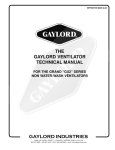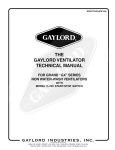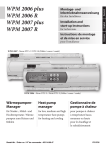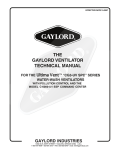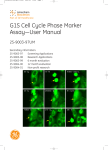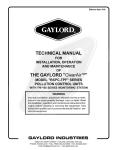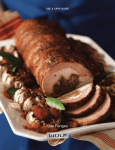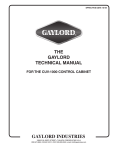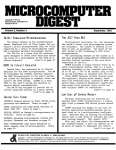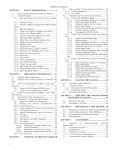Download Gaylord Industries
Transcript
EFFECTIVE DATE 4-05 THE GAYLORD VENTILATOR TECHNICAL MANUAL FOR THE Ultima VentTM “GX2-UV” SERIES NON WATER-WASH VENTILATORS GAYLORD INDUSTRIES 10900 S.W. AVERY STREET • TUALATIN, OREGON 97062-1149 U.S.A. 800-547-9696 • 503-691-2010 • FAX: 503-692-6048 • email: [email protected] GAYLORD INDUSTRIES “Undisputed World Leader in Engineered Systems for Commercial Kitchens”tm World Headquarters: 10900 S.W. Avery Street • Tualatin, Oregon 97062-1149 U.S.A. To Our Customers. . . Congratulations on your recent purchase of a Gaylord kitchen exhaust hood system. We are proud to be able to provide you with a quality product that incorporates the latest engineering concepts and is a result of over 50 years of experience in the foodservice kitchen exhaust industry. If you have other Gaylord equipment such as a Gaylord Utility Distribution System, Quencher Fire Protection System, or Roof Top Air Handling Equipment, etc., please refer to the corresponding supplementary equipment manuals. If you have further questions, please call us toll free at 1-800-547-9696 or email:[email protected]. We are more than happy to help. Sincerely, Gaylord Industries STREET ADDRESS: 10900 S.W. Avery Street, Tualatin, Oregon 97062-8549 U.S.A. PHONE: 503-691-2010 • 800-547-9696 • FAX: 503-692-6048 • email: [email protected] • www.gaylordusa.com COMMERCIAL KITCHEN EXHAUST SYSTEMS • FIRE PROTECTION • UTILITY DISTRIBUTION • ROOF TOP UNITS • POLLUTION CONTROL 2 TABLE OF CONTENTS “GX2-UV” VENTILATOR MODEL DESCRIPTION“ .............................................................. 4 “GX2-UV” SERIES PRINCIPLE OF OPERATION .......................................................... 5 – 7 MAINTENANCE AND CLEANING INSTRUCTIONS ............................................................. 8 UV PREVENTIVE MAINTENANCE ....................................................................................... 9 SAFETY CONCERNS WITH UV ........................................................................................ 10 START-UP PROCEDURES .............................................................................................. 11 MEASURING INLET SLOT VELOCITY ....................................................................... 12 –14 TROUBLESHOOTING ............................................................................................... 15 – 20 MODEL CUV-100 SERIES CONTROL CABINET ............................................................. 21 MODEL CUV-100 SERIES CONTROL .............................................................................. 22 PARTS LIST ...................................................................................................................... 23 UV MODULE PARTS ......................................................................................................... 24 GEM SYSTEM DIAGRAM ................................................................................................... 25 UV HOOD WIRING ............................................................................................................ 26 WIRING DIAGRAMS ................................................................................................... 27 – 28 STANDARD VENTILATOR MODELS ................................................................................. 29 METRIC CONVERSION CHART ....................................................................................... 30 START-UP INSPECTION REPORT .................................................................................. 31 WARRANTY ............................................................................................... Inside back cover PATENT NUMBERS U.S.A.: 4,266,529 4,281,635 4,356,870 CANADA: 1,139,151 1,155,366 GERMANY: 8,034,240 ALL RIGHTS RESERVED. NO PART OF THIS BOOK MAY BE REPRODUCED, STORED IN A RETRIEVAL SYSTEM, OR TRANSMITTED IN ANY FORM BY AN ELECTRIC, MECHANICAL, PHOTOCOPYING, RECORDING MEANS OR OTHERWISE WITHOUT PRIOR WRITTEN PERMISSION OF GAYLORD INDUSTRIES COPYRIGHT 2004. © Copyright 2005, Gaylord Industries The manufacturer reserves the right to modify the materials and specifications resulting from a continuing program of product improvement or the availability of new materials. ADDITIONAL COPIES $10.00 3 “GX2-UV” VENTILATOR MODEL DESCRIPTION There are 3 different types of “GX2-UV” “Grand Gaylord” non water-wash ventilators. The differences involve the type and location of fire damper and whether the ventilator has a fire damper. The first part of the model number indicates the type of ventilator, see below: Explanation of Prefixes: GX2-UV-FDD Non water-wash ventilator with removable extractor inserts and a fuse link activated fire damper located at the duct collar (weighted). [No Damper motor, No Thermostats] GX2-UV-EDD Non water-wash ventilator with removable extractor inserts and a thermostatically activated (electric) fire damper located at the duct collar. [ With Damper motor and 1 or more Thermostat(s)] GX2-UV-ND Non water-wash ventilator with removable extractor inserts and No Fire Damper. [No damper motor, No Thermostats] 4 “GX2-UV” SERIES PRINCIPLE OF OPERATION Some ventilators may be equipped with optional “Custom Air” baffles (shown dotted) to reduce the exhaust volume over specific light duty cooking appliances. The extractor inserts come in two sizes15½" (5.6 lbs.) and 19½" (6.75 lbs.). The Gaylord “GX2-UV” Series Non Water-Wash Ventilator offers simplicity, economy and performance that no other ventilator can offer. The unique “extractor insert” gives a grease extraction efficiency far superior to that of a typical baffle filter. The Gaylord “GX2-UV” Series Ventilators are UL Listed and meet all the requirements of NFPA #96 and the International Mechanical Code. Particulate Separator Once the largest particles of grease have been captured through inertial impaction by the baffles. The smaller particles of grease will be arrested in the particulate separator using the principles of diffusion and inertial impaction. EXHAUST FAN OPERATION The exhaust fan is controlled by the Gaylord CUV-100 Control Cabinet. The cabinet is usually located on a wall near the ventilator. When the control is turned on, the exhaust fan and UV Lamps will come on. UV Lamps Once the baffles and particulate separators have collected the grease particles larger than 1 micron. The UV lights will be able to break down the remaining grease by direct exposure to 254nm light and by the Ozone, Hydroxyl Radicals and Anionic oxygen created by the 187nm UV light. This will carry down the ductwork and continue to break down the grease, particulate and odor molecules keeping the ductwork much cleaner. The byproducts of this process are CO2, H20 and the base minerals from the grease and particulate matter coming off of the cooking surface. There will be a light gray dust that collects on the lamps, which will be need to wiped off. The ductwork will need to be inspected per NFPA-96 schedules but, will need much less frequent cleaning. GREASE EXTRACTION The Gaylord “GX2-UV” Series Ventilator extracts up to 99% of the grease, dust, and lint particles from the airstream passing through it. Grease extraction is accomplished by unique, removable stainless steel “extractor inserts” which incorporate a series of horizontal baffles. As the air moves through the extractor at high speed, it is forced to make a series of turns around these baffles, forcing the heavier-thanair particles of grease, dust, and lint to be thrown out of the airstream by centrifugal force. The sticky grease collects in the extractor and the liquified grease drains down into the main grease gutter which slopes to the grease cup. Note: IMPORTANT NOTE: Never operate ventilator without extractor inserts in place. GREASE EXTRACTION FIG. 1 5 “GX2-UV” SERIES PRINCIPLE OF OPERATION CLEANING At the end of the cooking day the exhaust fan is turned off at the CUV-100 control. After the fan has been turned off, the extractor inserts and particulate separators are removed and can be washed either in a dishwasher or soaked and rinsed off. The grease cup is also removed and emptied at this time. To ease in the removal of the extractor inserts, an “Extractor Removal Tool” is available which eliminates the need for kitchen personnel to climb up on the cooking equipment, or up a ladder. The UV lamps will develop a coating of dust. This coating must be removed for optimum performance. Therefore, once a week while the cartridges are removed, inspect the lamps and clean as needed. Use a clean dry cloth and if necessary wash with mild detergent and water first. FIG. 2 6 “GX2-UV” SERIES PRINCIPLE OF OPERATION FIRE PROTECTION When the temperature of the conveying airstream, which must pass over the thermostat(s), reaches 250°F, the Electric Damper at the Duct collar closes and the Exhaust and Supply fans and UV Lamps shut off, when the ventilator and fans are wired according to Gaylord’s wiring diagram. After the thermostat(s) cool below 250°F the damper will reset automatically, and the Exhaust and Supply fans will restart, if the CUV-100 control is turned “ON”. NFPA-96 requires the use of Surface Fire Protection (Duct, Plenum, Surface/Appliance) on all hoods. It is these systems that are the first line of defense against equipment fires. The “GX2-UV-FDD” Series ventilator incorporates a fuse link damper at the duct collar. In the event of a fire, should the fuse link at the duct collar reach 280°F, the fuse link melts allowing the damper to close. (See Fig. 3) After the fire is extinguished the fuse link(s) in the duct collar needs to be replaced and the damper reset. The “GX2-UV-ND” Series ventilator does NOT have a damper. The damper in the “GX2-UV-FDD” and the “GX2-UV-EDD” prevent the flames from entering the ductwork and spreading to other parts of the building. The fire is contained in the kitchen area where it can be properly fought. The “GX2-UV-EDD” Series ventilator incorporates an Electric Damper at the Duct collar and thermostat(s), which are located at the point where the ductwork joins the ventilator. FIG. 3 7 MAINTENANCE AND CLEANING INSTRUCTIONS CLEANING At the end of each cooking day, the exposed interior surfaces of the ventilator should be wiped down and the grease cup emptied. During the course of operation, grease particles are gradually collecting inside the extractor inserts and particulate separator. Daily, or at periodic intervals, depending on the type of cooking, the extractor inserts and particulate separators, must be removed and cleaned. To clean, proceed as follows: INSPECTION AND CLEANING REQUIREMENTS The 2001 edition of NFPA-96 (Standard for Ventilation Control and Fire Protection of Commercial Cooking Operations) require that hoods, ducts and exhaust fans be inspected by a properly trained, qualified and certified company or person(s) in accordance with the following table. Upon inspection, if found to be contaminated with deposits from grease-laden vapors, the entire exhaust system shall be cleaned by a properly trained, qualified, and certified company or person(s) acceptable to the authority having jurisdiction. 1. Remove extractor inserts by hand or by using the extractor removal tool. CAUTION: Care should be taken when removing extractors, especially over fryers. It is recommended that the cooking equipment be cooled down and the fryers be covered prior to removing extractors. To remove, lift up slightly on extractor insert and pull straight out. When a vent cleaning service is used, a certificate showing date of inspection or cleaning shall be maintained on the premises. After cleaning is completed, the vent cleaning contractor shall place or display within the kitchen area a label indicating the date cleaned and the name of the servicing company. It shall also indicate areas not cleaned. Factory trained service agencies are certified by Gaylord Industries, Inc. to perform these inspections. For the name and phone number of your nearest agent call 800-547-9696 or www.gaylordusa.com and go to service. 2. Extractor inserts may be cleaned either by using a dishwasher or by washing in a sink using hot water and a degreasing detergent. Formula G-510 is highly recommended for this application. For information contact: 20/10 Products Inc. P.O. Box 7609 Salem, OR 97303 Phone: 800-286-2010 Fax: 503-363-4296 E-mail: [email protected] EXHAUST SYSTEM INSPECTION SCHEDULE Type or Volume of Cooking 3. With the extractor inserts and particulate separators removed, wipe and clean the back wall and the grease gutter with hot detergent water. NOTE: If a steam or hot water pressure washer is used for periodic cleaning of the interior, connect a hose to the gutter drain and lead it to a floor sink or large bucket to drain off the water. Frequency Systems serving high-volume cooking operations such as 24-hour cooking, charbroiling or wok cooking Quar terly Systems serving moderate-volume cooking operations Semiannually Systems serving low-volume cooking operations, such as churches, day camps, seasonal businesses, or senior centers Annually CAUTION: Care should be taken when removing extractors, especially over fryers. It is recommended that the cooking equipment be cooled down and the fryers be covered prior to removing extractors. 4. To replace the extractor inserts, care must be taken to insure that point “A” rests in the rear clip as illustrated in Fig. 4. 5. If the ventilator(s) has a fuse link operated supply duct fire damper NFPA-96 requires inspection of the fuse link every 6 months and replacement annually. 6. UV lamps must be wiped down on a regular basis. This may need to be done as often as weekly on some systems. EXTRACTOR INSERTS DURING CLEAN-UP PROCEDURES AT THE END OF THE COOKING PERIOD THESE AREAS SHOULD NORMALLY BE WIPED DOWN. MAIN GREASE GUTTER DURING CLEAN-UP PROCEDURES AT THE END OF THE COOKING PERIOD SPECIAL ATTENTION SHOULD BE GIVEN TO WIPING CLEAN THE AIR INLET OF THE VENITLATOR FIG. 4 8 UV PREVENTIVE MAINTENANCE CERTIFIED SERVICE AGENT MAINTENACE WARNING! Warning: Do NOT defeat the purpose of the interlocks during cleaning and maintenance! Replacing UV Lamps These items will need to be performed by a trained and qualified Danger! Certified Service Agency (CSA) on the same schedule as the exhaust system inspection schedule described in NFPA-96 and These items will need to be performed by a trained and qualified on the previous page in this tech manual. These tasks involve Certified Service Agency (CSA). These tasks involve potential potential exposure to high doses of UV light and live electrical exposure to high doses of UV light and live electrical compocomponents. There is risk of injury to skin and eyes and in the case nents. There is a risk of serious injury to skin and eyes from UV light. There is risk of shock, injury, and/or death from electrical. of electrical shock, injury or death! For a list of CSAs go to For a list of CSA’s go to www.gaylordusa.com and go to the www.gaylordusa.com and go to "Service Agencies" for a list of “Service Agencies” for a list of certified companies nearest you. companies nearest you. 1. Inspection of the Lamps and Ballasts a. Check the lamps for proper operation 1. Secure all power to the CUV-100 control 2. Secure all circuits that provide power to the UV lamps 1. Turn on the fan and look for the green "UV System On" light on each hood section a. If it is not on refer to "UV Troubleshooting", pages 17, 18 and 20. 2. Open the UV Access door with the key 3. Turn on fan 4. Verify all of the Extractor Inserts are installed. 5. Depress the UV Access door safety switch 6. Check all indicator LEDs, 6 green and 3 red, to ensure that they are all on. If they are not all on go to "UV Troubleshooting", pages 17, 18 and 20. 3. Open the UV Access door with the key 4. Disconnect the UV module power cord 5. Remove the nuts holding the UV module to the ventilator with a nut driver 6. Remove the UV module from the ventilator 7. Remove the bolts on each end of the UV module (2 on each end) that hold the end caps on 2. Inspect the Plenum (around the UV lamps) a. Disconnect the UV module power cord b. Remove the nuts holding the UV module to the ventilator with a nut driver c. Remove the UV module from the ventilator d. Check for build-up of deposits of grease, dust and/or lint. e. Clean as necessary with a mild detergent, water and a rag f. Reinstall the UV module. 3. Test the Safety Interlock switches a. Remove one Extractor Insert with the fan on • The UV lamps should shut off • An audible alarm on the CUV-100 should come on • The Red “UV Safety Interlock Activated” light on the ventilator and CUV-100 control should come on b. Open the UV Access door with the fan on • The UV lamps should shut off • An audible alarm on the CUV-100 should come on • The Red “UV Safety Interlock Activated” light on the ventilator and CUV-100 control should come on c. Turn off the breaker to the Exhaust Fan. Press the “Start Fan” button on the CUV-100 control • The UV lamps should shut off (stay off) • An audible alarm on the CUV-100 should come on • The Red “UV Safety Interlock Activated” light on the ventilator and CUV-100 control should come on 4. Check all gaskets for damage a. Replace any gaskets that are worn or damaged 5. Check the Hour Meter a. Record the hours b. Determine the approximate hours between inspection intervals. c. Determine when the 8000-hour life of the lamps will occur and inform the operator of the approximate date when the lamps will need to be replaced 9 8. Disconnect the lamp connector(s) on the UV lamp(s) to be replaced • Each lamp connector should be labeled from 1 to 6 on both ends • Lamp #1 is at the Front of the ventilator when the UV module is installed • Lamp #6 is at the Back of the ventilator when the UV module is installed • Be sure to re-label the lamp connectors if necessary 9. Lubricate the lamps around the grommets on each end of the UV lamp with a small amount of G-510 or similar detergent 10. Slide the UV lamp out one end, CAREFULLY! 11. Inspect the grommets around the lamps • Replace any grommets that show cracks, checking, or any other damage 12. Check all wires for damage • Replace any wires showing damage 13. Lubricate each of the new UV lamp(s) before installing with a small amount of G-510 or similar detergent 14. Re-connect the lamp connectors on both ends of the UV lamps • Each lamp connector should be labeled from 1 to 6) on both ends • Lamp #1 is at the Front of the ventilator when the UV module is installed • Lamp #6 is at the Back of the ventilator when the UV module is installed 15. Re-install the UV module end caps and torque the bolts to 7-10 in-lbs. 16. Re-install the UV module in the ventilator 17. Tighten all nuts holding the UV module to the ventilator 18. Re-connect the UV module power cord 19. Check for proper operation of UV lamps SAFETY CONCERNS WITH UVC As with many types of technology if it is not used properly and/ or proper precautions are not taken there is the potential for injury or harm. This is especially true with UVC light due to the fact that it does not physically hurt at the time of exposure. While UVC is very effective at breaking down grease molecules, direct exposure to large amounts is harmful to skin and eyes. The amount of UVC generated in these hoods is greater than that what results from direct exposure to the sun. Under no circumstances is it acceptable to view the lighted lamps without proper eye protection or expose bare skin directly to the light. All interlocks and safety precautions called for in this manual must be followed to avoid the potential for harm to service personnel and/or operators. In addition, only trained and authorized personnel may perform some maintenance See previous page for details. Personal Protective Equipment 1. Eye protection that prevents 100% of UVC being transmitted through the lens must be worn at all times when performing service work on any Ultima Vent that is energized and/or has the potential to be energized and expose personnel to UVC light. 2. Whenever service work is performed it is recommended that long sleeve pants and shirts be worn to minimize the potential for inadvertent exposure of the skin to UVC. Safety Interlocks This product comes equipped with the following sensors to verify that all access doors are in place and that the exhaust fan is running: 1. Mechanical door switch on the UV Access door to ensure that the door is closed 2. Gaylord Extractor Monitor (GEM) that ensures all of the Extractor Inserts are installed. 3. Air Pressure switch to verify air flow and exhaust fan operation All of these devices must be working and/or adjusted properly in order for the system to operate properly. 10 START-UP PROCEDURES Before using the Ultima Vent a complete and thorough start-up of the Ultima Vent system must be performed by a qualified, and authorized service technician. Because of this the UV modules will be shipped separate from the hood to an Certified Service Agent(CSA). Contact Gaylord Industries to arrange for this service. It is normally included in the purchase price of the hoods. Start-up requirements and activities At the time of shipment a Certified Service Agent (CSA)will be selected to perform the installation of the UV modules and the start-up for the Ultima Vent system. 8. Check the air velocity at the inlet slot 9. Record the data on the start up form. Determine the correct inlet slot velocity and record that in the design velocity location. Then determine the percentage of design that the actual air velocity represents The Service agent should confirm the following prior to going to the job site: 11. Remove an Extractor Insert 1. The Exhaust and Supply fan(s) are connected to the ductwork 2. a. The red “Safety Interlock Activated” lamp should come on and an audible alarm sound. 12. Check the UV Access door interlock The fans have electricity and will run 3. The CUV-100 control panel is mounted and has the following: a. Open the UV Access door with the fan on.The red “Safety Interlock Activated” lamp should come on and an audible alarm sound. Caution: Before any Fire tests are performed, check with the building superintendent to see if the Surface Fire Protection system is wired to the building alarm, monitoring system, and/or fire department. a. Power to the CUV-100 b. All necessary electrical connections between the CUV100 and the hood, surface fire protection system, and fans. 4. All lighting wiring is connected to the hoods and light switch 5. There is a 120 Volt, 20 Amp power circuit going to each hood section, for UV lamps 13. If the FP contractor is there have them trip the micro switches on the FP system to verify that the Exhaust Fan(s) starts and supply Fan(s) shut off. 6. Any personnel (Fire Marshal, owners rep., GC, FP contractor, air balancer, etc) required to witness the start up would need to be notified of time and date for start-up. 14. Once all is working correctly demonstrate the following to the end user a. If the hood is interlocked with the FP system. Have the FP contractor test it and confirm that the External fire mode works properly. b. Instruct them that if for any reason they can see the UV light directly they must shut off the hood immediately and call a CSA. c. Check for proper damper operation if this hood has a damper d. How to remove, clean and replace the Extractor Inserts e. That they need to perform the required end user maintenance described in the tech manual and hire CSA to perform the UV maintenance as described in the tech manual and have the duct system inspected/or cleaned per the requirements of NFPA-96. f. The frequency will need to be adjusted based on the type, amount and duration of cooking done at this site. q. Fill out the start up form completely with comments r. Notify the Dealer/customer if the air volumes are more than 5% low or 10% high and give the dealer and GC a copy of the Start-up report. g. Send a copy of the Start-up report to Gaylord and keep a copy for your records. Field Start up directions Allow about 1 hour per hood section, at the job site, for the activities described below: 1. Check for power to the CUV-100 and wiring between the CUV-100 and the hoods 2. Check that all Extractor Inserts are properly installed 3. Start the exhaust fan by turning the CUV-100 control on. Both supply and exhaust fans should start. The green “UV System On” light should be on. If this does not occur refer to "UV Troubleshooting" on pages 17, 18 and 20. 4. Turn CUV-100 control off. This will shut off the fans. 5. Open the UV Access door and remove the blank plate from the UV light opening. 6. Install the UV light modules in the hood. Connect the plug on the UV module to the hood. 7. Start the exhaust fan and check for the green “UV System On” light at the hood(s) and control panel. Make sure that all access doors are closed. 11 MEASURING INLET SLOT VELOCITY MEASURING INLET SLOT VELOCITY Smoke capture and grease extraction efficiency are dependent upon the proper air velocity at the inlet slot of the ventilator.The required average slot velocities are shown on the “Air Velocity Chart” below. If the slot velocity is below the required average, the exhaust fan must be adjusted accordingly. NOTE: The height of the inlet slot can vary depending upon the design of the ventilator. It is, therefore, important to first measure the inlet slot and compare it to the chart below to determine the required average inlet slot velocity. The designed CFM per lineal foot is related to the velocity as shown on the chart below. The total CFM for the ventilator can be found on the ventilator nameplate. (See Figure 6). AIR VELOCITY CHART FOR ALL "GX2" SERIES EXCEPT "DS" SERIES Without Custom Air Baffles Nominal Height Designed of Inlet Slot CFM per Lineal Ft. With Custom Air Baffles Designed CFM per Lineal Ft. Average Inlet Slot Velocity (FPM) Min. Optimum Max. Average Inlet Slot Velocity (FPM) Min. Optimum Max. 3" 250 1300 1380 1450 150 760 800 880 (Std) 270 1360 1435 1500 160 790 830 870 285 1425 1500 1575 170 810 855 900 300 1465 1545 1625 180 845 880 935 400 1690 1780 1870 250 1040 1095 1150 4" (Enl) FOR "DS" SERIES VENTILATORS* Designed CFM Per Lineal Ft. Total Both Slots Required Average Inlet Slot Velocity (FPM) Front Slot Rear Slot Front Slot Rear Slot 300 150 150 760 800 880 595 625 655 400 250 150 1375 1450 1520 595 625 655 Min. Optimum Max. Min. Optimum Max. Air velocity readings less than what is specified on the “Air Velocity Chart” may allow smoke and grease to escape the confines of the ventilator and/or reduce grease extraction efficiency. This can result in grease deposits which lead to sanitation problems or fire hazards if left uncorrected. If air velocity readings are higher than those specified, it will require more energy to operate the exhaust fan and excessive noise levels will result. Higher or lower velocities than the required average will normally put the entire heating and ventilating system out of balance. When measuring the air velocity it is very important to take an average reading across the inlet slot plane as described on Page 13. Positioning the sensing head incorrectly will give velocity readings that cannot be compared to the “Air Velocity Chart”. 12 MEASURING INLET SLOT VELOCITY The standard instrument used for measuring the inlet velocities on a Gaylord Ventilator is a Pacer, Model DA40 or DA4000 Digital Anemometer. This instrument is the easiest, most accurate and the best suited for measuring ventilator inlet slot velocities. To take accurate air velocity readings, follow the instructions below. Instructions 1. It is first necessary to determine if the ventilator includes Custom Air baffles as shown in Fig. 5B. If shop drawings are available, and if equipped, the custom baffles and their location will be noted on the front elevation. If not available, to determine if Custom Air baffles are provided run your hand along the bottom inlet slot and feel for the Custom Air baffle as illustrated in Fig. 5B. 2. If the ventilator includes Custom Air baffles, it will be necessary to take two sets of readings - one for the section of ventilator that includes Custom Air baffles and one where it does not. 3. Attached the sensing head guide bracket, Gaylord Part Number 18408, to the sensing head. FIG. 5A 4. Attach the cable from the sensing head to the meter and the handle sections to the sensing head. 5. Place the sensing head guide bracket against the lower lip of the inlet slot as illustrated. 6. Using the 16 second averaging feature on the meter, slide the sensing head along the slot, back and forth, for a 3'-0" to 4'-0" distance, and record the velocity at the end of the 16 second mark. Continue this process for the full length of the ventilator. Important Note: If the ventilator includes custom air baffles as illustrated in Fig. 5B, always take separate readings on the section of the ventilator that includes custom air from the section that does not have the baffles. Non custom air and custom air readings must be recorded separately. Do not average them together. Important Note: On the rear slot of a Model BDL-DS Series, do not use the guide bracket. Refer to Figure 5C. 7. Record the velocity (fpm) on the start up inspection report form. A sample report form, which can be photocopied, is provided on page 16. 8. The designed, or optimum velocity, is noted on the shop drawings and the Air Velocity Chart on page 12. Two velocities will be noted if the ventilator includes custom air baffles. FIG. 5B 9. Compare the recorded air velocity to the designed air velocity shown on the shop drawings or the Air Velocity Chart on page 12. The recorded velocity may be slightly lower or higher providing that it is within the minimum and maximum range as shown on the Air Velocity Chart . If the air velocity is outside the minimum/maximum range, the performance of the ventilator will be affected and therefore the exhaust fan must be adjusted. FIG. 5C CROSS SECTION OF TYPICAL VENTILATOR INLET SLOTS 13 MEASURING INLET SLOT VELOCITY ENGINEERING DATA LISTED 370Y EXHAUST HOOD WITH EXHAUST DAMPER THIS EXHAUST HOOD HAS BEEN TESTED TO STANDARD UL 710 "EXHAUST HOODS FOR COMMERCIAL COOKING EQUIPMENT" THIS EXHAUST HOOD IS LISTED UNDER UL FILE NUMBER 11403 THIS EXHAUST HOOD MEETS ALL REQUIREMENTS OF THE LATEST EDITION OF NFPA96 AND THE IMC (INTERNATIONAL MECHANICAL CODE) o 1. MINIMUM TOTAL EXHAUST VOLUME FOR THIS HOOD SECTION C.F.M. 2. MAXIMUM TOTAL SUPPLY VOLUME FOR THIS HOOD SECTION C.F.M. 3. EXHAUST STATIC PRESSURE AT DUCT COLLAR W.G. 4. SUPPLY STATIC PRESSURE AT DUCT COLLAR W.G. ˚F FOR LINEAL FT. OF HOOD ˚F FOR LINEAL FT. OF HOOD 6. REFER TO GAYLORD VENTILATOR TECHNICAL MANUAL FOR INLET VELOCITY REQUIREMENTS AND METHOD OF CHECKING VELOCITY 8. ON "GX2" and "PG" SERIES VENTILATORS EQUIPPED WITH FUSE LINK OPERATED EXHAUST FIRE DAMPER USE ONLY 280˚ F , RATED 30 LBS. MIN. UL LISTED FUSIBLE LINK FOR REPLACEMENT 9. IF HOOD IS EQUIPPED WITH INTEGRAL MAKE-UP AIR WITH FUSE LINK OPERATED FIRE DAMPER USE ONLY 165˚ F, RATED 30 LBS. MIN. UL LISTED FUSIBLE LINKS FOR REPLACEMENT 10.DUCTWORK AND EXHAUST FAN A. STATIC PRESSURE OF DUCT SYSTEM MUST BE ADDED TO VENTILATOR STATIC FOR TOTAL SYSTEM STATIC B. ALL DUCTWORK MUST BE WELDED LIQUIDTIGHT MINIMUM DISTANCE FROM COOKING SURFACE TO FRONT LOWER EDGE OF HOOD MAXIMUM DISTANCE FROM COOKING SURFACE TO FRONT LOWER EDGE OF HOOD MINIMUM OVERHANG FROM FRONT OF HOOD CAVITY TO FRONT OF COOKING SURFACE MINIMUM OVERHANG FROM SIDE OF HOOD TO EDGE OF COOKING SURFACE WORLD HEADQUARTERS GAYLORD INDUSTRIES, INC. 10900 S.W. AVERY STREET TUALATIN, OR 97062-8549 USA PHONE: 1-503-691-2010 FAX: 1-503-692-6048 EMAIL: [email protected] UL-GX2/PG 1000 FIGURE 6 7. ELECTRICAL RATING OF LIGHT FIXTURES: 120 VOLT, 60 HZ. OR 220 VOLT, 50 HZ. OVERALL RATING - 12 AMPS OR LESS MAXIMUM SETBACK FROM FRONT OF HOOD CAVITY TO FRONT OF COOKING SURFACE PATENT PENDING TOTAL SUPPLY CFM HERE 5. THIS HOOD SECTION SUITABLE FOR APPLIANCES WITH MAXIMUM COOKING SURFACE TEMPERATURE OF: HOOD MOUNTING REQUIREMENTS SUPPLIED WITH FACTORY INSTALLED UL LISTED GRINNELL CORP. EA-1, 1/4" ORIFICE, 65 DEGREE DEFLECTOR SPRINKLER(S) FOR THE PROTECTION OF UNLIMITED LENGTH OF GREASE DUCT HAVING A MAXIMUM DUCT PERIMETER OF 50 INCHES PER SPRINKLER. CONNECT TO NFPA 13 SPRINKLER SYSTEM WATER SUPPLY ONLY. TOTAL EXHAUST CFM HERE SERIAL NO: MODEL NO: MAINTENANCE INSTRUCTIONS 1. REMOVE, INSPECT AND CLEAN FILTERS OR GAYLORD EXTRACTOR CARTRIDGES AS REQUIRED 2. REMOVE AND EMPTY GREASE CUP AS REQUIRED 3. CAUTION - DO NOT OPERATE VENTILATOR WITHOUT FILTERS OR EXTRACTOR CARTRIDGES IN PLACE 4. REPLACE FILTERS IN "PG" SERIES ONLY WITH UL CLASSIFIED GREASE FILTERS. IN "PGX" AND "GX2" SERIES REPLACE WITH GAYLORD INDUSTRIES EXTRACTOR CARTRIDGES. 5. IF THE VENTILATOR(S) HAS A FUSE LINK OPERATED EXHAUST OR SUPPLY DUCT FIRE DAMPER THE NATIONAL FIRE PROTECTION ASSOCIATION'S PAMPHLET NFPA-96 REQUIRES INSPECTION OF THE FUSE LINK EVERY 6 MONTHS AND REPLACED ANNUALLY. REFER TO THE GAYLORD VENTILATOR TECHNICAL MANUAL FOR DETAILS. 14 The total required exhaust volume can be found stamped on the UL nameplate located on each hood section. TROUBLE-SHOOTING SYMPTOM SMOKE LOSS 1. Smoke Loss- Ventilator is not exhausting properly. POSSIBLE PROBLEM CORRECTIVE ACTION A . L o w a i r ve l o c i t y- A ve r a g e a i r ve l o c i t y t hr o ug h t he a i r e nt r y s l o t s ho ul d b e i n accordance with the Air Velocity Chart on page 12. For proper method of measuring the a i r ve lo c i ty, re fe r to p a g e 1 3 . If the velocity is low check the following. 1. Broken or slipping belt on the exhaust fan. 2. Proper rotation of the exhaust fan wheel. 3. Proper size of exhaust fan (fan must deliver nameplate rating). 4. Ductwork inspection panel left open. 5. Damper not open or in proper position. B. The Gaylord Venti lator must have i ts own exhaust system and no other exhaust, such as dishwasher hoods, should be tied into it. 1. Inspect duct system and veri fy that there are no type II ventilator systems tied in. If so they must be removed. C. Improperly placed make-up air diffusers. 1. Make-up ai r di rected at the venti lator wi ll likely create cross drafts disrupting the air flow into the ventilator. Adjust the louvers to d i re ct the ma ke -up a i r a wa y fro m the ventilator. 2. Make-up ai r should be deli vered through full length perforated diffusers or registers at ceiling height distributed throughout the kitchen area. 3. Ma k e -up a i r re g i s te rs lo c a te d ne a r the ventilator, the louvers should be adjusted to d i r e c t the a i r a wa y fr o m the ve nti la to r. D i re c ti ng o r fo rc i ng ma k e -up a i r a t the ve nti la to r typ i c a lly c re a te s c ro s s d ra fts resulting in smoke loss. D. Inadequate make-up air. 1. M a k e - u p a i r m u s t b e s u p p l i e d f o r replacement of ai r exhausted through all kitchen exhaust systems. 2. A general " rule of thumb" i s that 75% to 80% of the replacement air should be fresh, conditioned, (heated or cooled) air brought i nto the ki tchen area, wi th the remai ni ng 20% to 25% allowed to flow into the kitchen from adjacent areas. E. Exhaust fan discharge. 1. T h e r e s h o u l d b e n o s c r e e n o v e r t h e d i s c ha rg e . If o ne i s fo und , i t s ho uld b e removed. 2. The di recti on of di scharge should not be i nto the p re va i li ng wi nd s no r d o wnwa rd onto the roof. A vertical discharge is highly recommended. GREASE EXTRACTION 1. Poor Grease Extraction. A. The Gaylord "GX2-UV" Ser ies Ventilator extracts up to 99% of the grease, dust and l i nt par t i cl es f r om t he ai r st r eam passi ng through it, when operated and maintained in accordance with design specifications. If i t appear s t hat t he vent i l at or i s not extracting proper ly, typically the exhaust volume is low. 15 1. Check the inlet slot velocity as described on pages 12 through 13. If the velocity is not wi t h i n t h e r e q u i r e d r a n g e, i n c r e a s e o r reduce the fan speed as required. TROUBLE-SHOOTING S YMP T OM E X H AU S T FAN 1. If whe n the fa n swi tch i s turne d o n the exhaust fan does not come on. P OS S IB L E P R OB L E M C OR R E C T IV E AC T ION A. Overload protector on magnetic starter tripped. 1. P u s h t h e " R e s e t " b u t t o n o n t h e m a g ne t i c s t a r t e r a nd t he p us h t he " S t a r t F a n" b ut t o n o n t he c o m m a nd c e nt e r. B. If a n HOA (Ha nd s On/A uto ma ti c) typ e ma g ne ti c s ta rte r s wi tc h i s us e d , the se le cto r swi tch ma y ha ve b e e n mo ve d fro m the a uto ma ti c p o si ti o n 1. C he c k s wi tc h a nd turn s e le c to r to the a uto ma ti c p o si ti o n. C. Exhaust fan circuit breaker tripped. 1. Re-set circuit breaker D . If t h e s y s t e m i s e q u i p p e d w i t h a n d i sco nne ct swi tch fo r the e xha ust fa n, a fuse o r fuse s ma y ha ve b lo wn o ut. 1. C h e c k c o n t i n u i t y o f f u s e s a n d re p la ce i f ne ce ssa ry. 16 TROUBLESHOOTING UV SYSTEM Danger! These items will need to be performed by a trained, qualified and Certified Service Agency (CSA). These tasks involve potential exposure to UV light and live electrical components. SYMPTOM 1. 2. After CUV-100 is turned on, fan starts: * Yellow "UV Lamp Failure" light is on * Audible Alarm is on * Yellow "UV Lamp Failure" light is on * Green "UV System On" light is on There is risk of injury to skin and eyes and in the case of electrical shock, injury or death! For a list of CSA’s Go to www.gaylordusa.com and go to Service for a list of companies nearest you. POSSIBLE PROBLEM CORRECTIVE ACTION A. No power to the ventilator section(s). 1. Check for 120 Volts on between L1 & L2 at ventilator. If there is no power at L1 and L2 coming to this ventilator section identify the circuit breaker, correct and re-check. B. Loose wire between CUV-100 and ventilator. 1. Check for 120 Volts between 6U and 5U in the ventilator. If none check CR13 in the CUV-100 for power and operation. If there is power there check for 120 volts between 1U and 5U. If there is power, check the green lamps for proper operation. C. No start signal from CUV-100 to ventilator section(s). D. Fuse is blown on UV Controller in ventilator. 1. Check Fuse F7 in CUV-100. E. The contactor has failed (CR20). 1. If there is power to L1 and L2. Check for power to the contactor coil (CR20). Correct lack of power. F. Green "UV System On" light has failed. 1. Check for power to the Green "UV System On" light a. If no power, Check the circuit and locate problem. b. If there is power the Green "UV System On" light has failed and needs to be replaced. A. UV Lamp or UV Ballast has failed. 1. Identify ventilator section with Yellow “UV Lamp Failure” light on. * Audible Alarm is on 1. Check Fuse F2 on the UV Controller. 2. With fan running, Open UV Access door 3. Depress the UV Access door switch and identify which Lamp/Ballast’s green light is not on 4. Switch the pin connector on that Ballast with another Ballast and check again a. If the alternate Ballast’s green light comes on, replace the Ballast b. If the alternate Ballast’s green light does not come on, replace the Lamp 3. Yellow "UV Lamp Failure" light is on ONLY at CUV-100 control NOT on any of the ventilator sections. B. The contacts on the UV Controller have closed permanently. 1. Check for continuity between 2A and 3A in ventilator. If there is continuity AND all of the UV lamps are working, (6) green and (3) red lights on at the UV Controller, the UV Controller needs to be replaced. C. Relay CR22 in ventilator has failed. 1. With Exhaust fan on, check for continuity across the N.O. contacts of CR22 in the ventilator. If there is continuity AND all of the UV lamps are working, replace relay CR22. D. Relay CR12 in CUV-100 has failed. 1. Check CR12 for proper operation, replace if necessary. 1. Check the Yellow "UV Lamp Failure" light and see if it is receiving power. a. If no, the problem is in the wiring. Locate and correct the problem b. If yes, replace the lamp. A. Yellow "UV Lamp Failure" light on ventilator has failed. 17 TROUBLESHOOTING UV SYSTEM SYMPTOM 4. During the lamp inspection one of the UV Controllers does not have (6) Green & (3) Red indicator lights on and there is no Yellow "UV Lamp Failure” lamp on. POSSIBLE PROBLEM A. The Yellow "UV Lamp Failure" light has failed. B. The Connection from the 2A on the UV Controller and the terminal blocks is broken or loose. 5. Red “UV Safety Interlock Activated” light on AND Audible Alarm on. 1. Check for continuity between 2A and 3A at ventilator. If a UV lamp has failed and there are (6) green and (3) red lights on on the UV Controller, the UV Controller needs to be replaced. A. UV Access Door Switch (DS) has failed or needs to adjusted. 1. Check for continuity between D1 & D2 and D3 & D4 with the door switches depressed. If there is 2. If there is continuity check the UV Pressure Switch and UV Proximity Switch. 1 Remove and re-insert Extractor Insert C. Gaylord Extractor Monitor (GEM) has failed 1. Check for continuity between G1 and G2. D. Pressure switch (PS) has failed or needs adjusting. 1. Check for power to the UV Pressure Switch with the fan on. 2. Check for continuity between P1 and P2. It should be closed with the fan on 3. With the fan on turn the pressure switch adjustment screw Clockwise until there is continuity between P1 and P2. D. Pilot tube to sense air pressure is plugged. E. Relay CR23 in ventilator has failed. F. Relay CR11 in CUV-100 has failed. 7. Audible alarm comes on for approximately 60 Seconds each day when "Start Fan" button is pressed. 2. If the Yellow "UV Lamp Failure" light has power, replace the light. 1. It may be the contacts on the ballast a. Check for power coming out of terminal 2A in the ventilator C. The contacts on the UV Controller has failed to close. B. An Extractor Insert has been removed or is not properly inserted 6. Pressing "Cancel Audible Alarm" button on CUV-100 does NOT silence alarm. CORRECTIVE ACTION 1. Check the Yellow "UV Lamp Failure" light and see if it is receiving power. a. If no, the problem is in the wiring. Locate and correct the problem b. If yes, replace the lamp. A. Timing Relay TR1 in CUV-100 is not set correctly or has failed. 4. If there is continuity, check the UV Access Door Switch and the UV Proximity Switch 1. Check the Pitot tube for blockage. Clear and check again. 2. Check all tubing connections to make sure they are tight. 1. With Exhaust fan on, close Inspection (wash access) doors and depress UV Access Door switches. Check for continuity across the N.O. contacts of CR23 in the ventilator. If there is continuity, replace relay CR23. 1. Check CR11 for proper operation, replace if necessary. 1. Check TR1 for proper operation and verify it is set for 1 second. B. Relay CR10 in CUV-100 has failed. 1. Check Yellow “UV Lamp Failure” lights. Identify which ventilator section(s) has the same light on. If it is on, see above for solution. A. Timing Relay TR2 in CUV-100 is not set correctly or has failed. 1. 18 Check TR2 for proper operation and verify it is set for 60 seconds. TROUBLESHOOTING CUV-100 TERMINAL VOLTAGES TERMINAL DESCRIPTION FAN OFF FAN ON EXT. FIRE L1 Main Power Connection : Hot 120 VAC 120 VAC 120 VAC TROUBLESHOOTING UV SYSTEM Common L2 Main Power Connection : Neutral 1 Output to Supply Fan Motor Starter 0 VAC 120 VAC 0 VAC High Voltage Common 5 120 VAC Neutral Leg 8 Output to Exhaust Fan Motor Starter 0 VAC 120 VAC 120 VAC FS1 Supply Fan Fire Switch Connections Closed Closed Open FS2 N.C. Contacts FS3 Exhaust Fan Fire Switch Connections Open Open Closed FS4 N.O. Contacts 1U Input from "UV System On" (Green) 0 VAC * * 2U Input from "UV Lamp Failure" (Amber) 0 VAC * * Input from "UV Safety Interlock Activated" 3U 0 VAC * * (Red) High Voltage Common 5U 120 VAC Neutral Leg 6U Output to UV Lamps Contactor 0 VAC 120 VAC 120 VAC 120 VAC - when UV lights should be on 0 VAC - when UV lights should be off (Refer to UV Status Light Chart on following page) 19 TROUBLESHOOTING UV Status Lights UV Status Lights UV System Mode All UV Lamps ON "Normal" One or more UV Lamps not working UV Module un-plugged No power to the UV Module (All Doors closed) UV Access Door Open Inspection (Wash Access) Door Open Exhaust Fan is not running at full speed Red Green Yellow "UV Safety Interlock "UV System On" "UV Lamp Failure" Activated" light on light on light on X X X X X X X X X The UV System is designed to run whenever the Exhaust Fan is running. The UV Status Lights will only activate when the UV System should be on. (Exhaust Fan Running) "UV System On" (Green) Light * ON when UV System is energized "UV Lamp Failure" (Yellow) Light * ON whenever UV System is energized and one or more of the UV Lamps and/or UV Ballasts have failed or if the UV Lamps do not have power * The rest of the UV Lamps will continue to run - call a Certified Service Agent for service "UV Safety Interlock Activated" (Red) Light * ON when a UV Access Door is open * ON when a Inspection (Wash Access) Door is open * ON when UV Pressure Switch detects that the static pressure is too low * All UV Lamps will shut off immediately, whenever any of the above happens UV Controller Status Lights Normal Operation • 3 Red lights on • 6 Green lights on UV Lamp Failure • "Summary Alarm" light is OFF • The Green light for the UV Lamp/Ballast that has failed will be OFF NOTE: • UV Lamps are numbered 1 to 6 from Front-to-Back • UV Ballasts are numbered 1 to 6 from Left-to-Right • The TOP of the UV Module has several long slots cut-out for ventilation 20 MODEL CUV-100 CONTROL CABINET 1 2 3 4 5 6 7 8 9 PC. NO. 1 2 3 4 5 6 7 8 DESCRIPTION UV Status Light Label Indicator Light - Red Indicator Light - Yellow Indicator Light - Green Cancel Switch Hour Meter C-150 Label C-150 Switch 21 GAYLORD PART NO. 19397 19162 12510 12512 19076 19164 18644 18314 MODEL CUV-100 SERIES CONTROL 1 2 3 4 5 6 7 8 PC. NO. DESCRIPTION 1 Fuse (F7) - 4 Amp 2 Control Relay [CR10] (Cancel Alarm) Socket 3 Control Relay [CR11] (Safety Interlock) Socket 4 Control Relay [CR12] (Lamp Failure) Socket 5 Control Relay [CR13] (System On) Socket 6 Timing Relay [TR1] (To Latch the Audible Alarm) Socket Timing Relay [TR2] (Delays Audible Alarm until 7 Exhaust Fan reaches operating speed) Socket 8 Sonalert 22 GAYLORD PART NO. 10039 11399 11413 11399 11413 11399 11413 11399 11413 30375 30376 30375 30376 30528 MFG PART NO. BUSS AGC-4 PARTS LIST GAYLORD PART NO. DESCRIPTION ILLUSTRATION 75890 75891 15-1/2" Extractor Insert (Left Astragal) 19-1/2" Extractor Insert (Left Astragal (Std-250 CFM/Lin. Ft. Extractors) 75896 75897 15-1/2" Extractor Insert (Left Astragal 19-1/2" Extractor Insert (Left Astragal (Enl-400 CFM/Lin. Ft. Extractors) 75892 75893 15-1/2" Extractor Insert (Right Astragal) 19-1/2" Extractor Insert (Right Astragal (Std-250 CFM/Lin. Ft. Extractors) 75894 75895 15-1/2" Extractor Insert (Right Astragal 19-1/2" Extractor Insert (Right Astragal (Enl-400 CFM/Lin. Ft. Extractors) 10321 10323 165°F Fuse Link for Supply Ducts 280°F Fuse Link for Exhaust Ducts 18400 Extractor Removal Tool (For 250+ 400 CFM/Lin.Ft. Extractors) 10119 Light Globe 13211 Incandescent Light Lens & Frame 12" x 12" Recessed Light Lens & Retainer 13210 10111 10112 Fluorescent Light Lens & Frame 2 Ft. Recessed Light Lens & Retainer 3 Ft. Recessed Light Lens & Retainer 4 Ft. Recessed Light Lens & Retainer 13075 Grease Cup 3-1/4" x 6" x 4" 19351 UV Access Door Latch 19365 UV Pressure Switch 23 UV MODULE PARTS 1 16 2 3 15 11 4 10 14 9 8 5 7 NOTE: • UV Lamps are numbered 1 to 6 from Front-to-Back • UV Ballasts are numbered 1 to 6 from Left-to-Right • The TOP of the UV Module has several long slots cut-out for ventilation PC. DESCRIPTION NO. 1 UV Light Grommet UV Lamp - 3 Foot 2 UV Lamp - 5 Foot 3 UV Lamp Holder 4 1/4" Nylon Washer 5 1/4"-20 x 2-1/2" Bolt 6 1/4" Retaining Clip (Not Shown) 7 UV Light Ballast 8 Circuit Board Stand-off 9 Fuse (F1) - 500mAmp UV Controller 10 Fuse (F2) - 8 Amp UV Controller - Main UV Light Controller (includes status lights circuit 11 board - not shown) 12 UV Wiring Harness (Not Shown) UV-3 Gasket Kit - includes: 1) UV-3 Frame Gasket 2) UV-3 Access Door Gasket 3) Left & Right UV Chase Gaskets for End Caps 4) Plenum Access Gasket 13 UV-5 Gasket Kit - includes: 1) UV-5 Frame Gasket 2) UV-5 Access Door Gasket 3) Left & Right UV Chase Gaskets for End Caps 4) Plenum Access Gasket GAYLORD PART NO. 19312 19296 19301 19313 19357 19356 19358 19237 19308 18153 19424 PC. NO. 14 19236 18 15 16 17 19349 75878 75879 24 DESCRIPTION UV Chase Cover - Left UV-3 Ballast Cover UV-5 Ballast Cover UV Chase Cover - Right UV-3 Light Module Frame - ALL Sheet Metal parts * Includes: Bolts, Washers, & Retaing Clip * Does NOT include Gaskets or Grommets UV-5 Light Module Frame - ALL Sheet Metal parts * Includes: Bolts, Washers, & Retaing Clip * Does NOT include Gaskets or Grommets UV-3 Light Module (Complete) - Complete with UV Controller, Ballasts, & UV Lamps, UV Wiring Harness, & Frame Gaskets UV-5 Light Module (Complete) - Complete with UV Controller, Ballasts, & UV Lamps, UV Wiring Harness, & Frame Gaskets GAYLORD PART NO. 19290 19300 19305 19291 19307 19306 75876 75877 GEM SYSTEM DIAGRAM 25 UV HOOD WIRING 20 PC. NO. DESCRIPTION 30529 CR21, Control Relay 23,24 Socket 11399 Control Relay 10283 CR22 Socket LT1 Indicator Light - Green LT2 Indicator Light - Yellow LT3 Indicator Light - Red DS UV Access Door Switch PS UV Pressure Switch GEM Gaylord Extractor Monitor UVP UV Plug - Female CF Cooling Fan 22 23 24 GEM UV Hood T erminal Schedule GAYLORD PART NO. CR20 Contactor 21 Te rm ina l L1 L2 1U 2U 3U 5U 6U P1,P2 D1,D2 G1,G2 D3,D4 1A 3A 4A 5A 6A 11413 10295 12512 19162 12510 19355 19365 19427 16903 30424 26 De scription Main Power Connection : Hot Main Power Connection : Neutral Output - "UV System On" (Green) Output - "UV Lamp Failure (Yellow) Output - "UV Safety Interlock Activated" (Red) 120VAC Neutral Leg Switched Power for UV Lamp Circuit Terminals for Pressure Switch #1 Terminals for UV Access Door Switch #1 Terminals for Gaylord Extractor Monitor (GEM) Terminals for UV Access Door Switch #2 UV Controller - Summary Alarm - N/C UV Controller - Summary Alarm - Common UV Controller - Input Power - Ground UV Controller - Input Power - Hot UV Controller - Input Power - Neutral Type 120VAC 0V 120VAC 120VAC 120VAC 0V 120VAC 120VAC 120VAC 120VAC 120VAC 120VAC 120VAC 0V 120VAC 0V WIRING DIAGRAM FOR MODEL CUV-100 WITH GX2-UV-FDD AND GX2-UV-ND HOODS 27 WIRING DIAGRAM FOR MODEL CUV-100 WITH GX2-UV-EDD STANDARD VENTILATOR 28 STANDARD VENTILATOR MODELS Model GX2-UV-FDD-BDL Model GX2-UV-FDD-BDL-CL Application - Wall mounted canopy style for all types of equipment. Application - For single island arrangements Model GX2-UV-FDD-BDL-DS Model GX2-UV-FDD-BDL-BB Application - For island style cooking arrangements where one side of the cooking line is light duty equipment and the other side medium duty equipment. Application - For island style cooking arrangements over all duties of equipment. MODEL “MAW” SERIES MODEL “MAI” SERIES FRONT FACE DISCHARGE INTERNAL DISCHARGE This method of introducing make-up air into the kitchen is flexible and has many advantages. Make-up air is discharged through stainless steel perforated panels as illustrated (MAW Series) or optional registers (MAR Series). Typical supply volume is 80% of the exhaust or more, depending on air balance desired. Supply air temperatures should range from 60 to 65°F (16 to 18°C), but may be as low as 50°F (10°C) depending on air volume, distribution, and internal heat load. This method of introducing air into the hood is typically referred to as the “short circuit” method. This design has very limited applications and the amount of supply air able to be introduced varies considerably with the type of cooking equipment. This air may be untempered air in most areas depending upon climatic conditions and the type of cooking equipment. The difference between the quantity of air being introduced and the amount of air being exhausted must be supplied through a traditional make-up air system. 29 METRIC CONVERSION CHART DIMENSIONS (Feet and Inches) WATER FLOW/VOLUME TO CONVERT TO MULTIPLY BY in ............................ in ............................ mm .......................... cm .......................... ft ............................. ft ............................. cm .......................... m ............................ mm .............. 25.4 cm ................. 2.54 in ................... 0.03937 in ................... 0.3937 cm ............... 30.48 m ................... 0.3048 ft ................... 0.0328 ft ................... 3.2808 one in. = 25.40 mm one ft. = 304.80 mm MULTIPLY BY Liters ................... .02958 Liters ................. 3.785 U.S. gal ............. 0.2642 L/s ..................... 0.0631 GPM ................ 15.850 TO CONVERT TO STANDARD CONVERSIONS 40 psi = 2.8 kg/cm2 80 psi = 5.6 kg/cm2 = 275.8 Kpa = 551.6 Kpa = 2.758 BAR = 5.516 BAR CFM ........................ Ltrs/sec ............. 0.472 m3/sec ................... CFM ............. 2118.88 m3/min .................... CFM ................. 35.31 TEMPERATURE TO CONVERT TO USE FORMULA ° C .......................... ° F ............ °F = (°C • 1.8) + 32 ° F .......................... ° C ........... °C = (°F - 32) 1.8 STANDARD CONVERSIONS 140°F. to 180°F. = 60°C. to 82°C. m3/hr ...................... CFM ................... 0.5886 STATIC PRESSURE MULTIPLY BY in. W.G .................... N/m2 .............. 248.84 N/m2 ....................... in. W.G. ............. 0.004 WEIGHT STANDARD CONVERSIONS 1.00" W.G. = 248.84 or 248.84 MULTIPLY BY kg/cm2 ................... psi ................... 14.223 MULTIPLY BY CFM ........................ m3/sec .............. 0.000472 CFM ........................ m3/min ............... 0.02832 CFM ........................ m3/hr ................. 1.70 TO TO psi .......................... kg/m2 ............ 703.1 psi .......................... kg/cm2 .............. 0.0703 kg/m2 ..................... psi ..................... 0.0014 AIR VOLUME TO CONVERT U.S. ounce .............. U.S. gal ................... Liters ...................... GPM ....................... L/s .......................... WATER PRESSURE TO FPM ........................ m/s .................... 0.00508 m/s ......................... FPM ............... 196.85 TO CONVERT MULTIPLY BY STANDARD CONVERSIONS AIR VELOCITY TO CONVERT TO one U.S. gal. ........... = ............... 3.785 Liters one Liter ................. = ............... 0.2642 U.S. Gal. one GPM/ft. ............ = ............... 0.063 L/s/ft. or .............. 0.207 L/s/m one U.S. gal. ........... = ............... 0.833 Imperial Gal. one Imperial Gal. .... = ............... 4.546 Liters STANDARD CONVERSIONS One meter = 10 dm One meter = 100 cm One meter = 1000 mm TO CONVERT N/m2 Pascals (Pa) or 2.49 Millibars 1.33" W.G. = 331 N/m2 or 331 Pa 1.50" W.G. = 373 N/m2 or 373 Pa 1.65" W.G. = 411 N/m2 or 411 Pa 1.70" W.G. = 423 N/m2 or 423 Pa TO CONVERT TO lbs. ......................... lbs. ......................... N............................. kg ........................... N ....................... 4.448 kg ...................... 0.4536 lbs ..................... 0.2248 lbs ..................... 2.2046 MULTIPLY BY PIPE SIZE U.S. STANDARD PIPE SIZES STANDARD METRIC EQUIVALENT PIPE SIZE 1/2" ................ 3/4" ................ 1" ........................ 1-1/4" .................. 1-1/2" .................. 2" ........................ = ...................... 15 mm = ...................... 20 mm = ...................... 25 mm = ...................... 32 mm = ...................... 40 mm = ...................... 50 mm LEGEND in. = inches Pa. = Pascals FPM = feet per minute ft. mm cm dm CFM m3/s L = = = = = = = feet milimeters centimeters decimeters cubic feet per minute cubic meters per second Liters U.S. gal. GPM L/s Kpa psi kg/m2 ° F. = = = = = = = U.S. gallon gallons per minute liters per second 1000 Pascals pounds per square inch kilograms per square meter degrees Fahrenheit m/s in. W.G. N N/m2 ° C. BAR = = = = = = meters per second inches water gauge Newtons Newtons per square meter degrees Celsius one atmospheric pressure meter (1000 millibars = 14.7 psi) 30 VENTILATOR START-UP INSPECTION REPORT For Model “GX2-UV” Series Ventilators Job Name ______________________________________________________________________________ Gaylord Representative ____________________________________________________________ Address ________________________________________________________________________________ Representative Company Name ______________________________________________________ ______________________________________________________________________________________ City/State Zip File Number _______________________________________________ Date _________________ Facility Contact Name _________________________________________ Phone # ____________________ CSA Contacted __________________________________________________________________ MAKE-UP AIR 3. If the “GX2” Series ventilator(s) is interconnected with any “CG3” water wash series, perform the following test: A. With the exhaust fan on, open the electrical compartment on the control cabinet and push the “FIRE TEST” button. The following should occur: 1. Exhaust fan shut off ___Yes ___No 2. Damper fully closed ___Yes ___No B. At conclusion of the test push the “CANCEL” button. The following should occur: 1. The damper stayed closed ___Yes ___No 2. Fan stayed off ___Yes ___No C. Push the “START FAN” button. The following should occur: 1. Damper moves to the fully open position ___Yes ___No 1. Kitchen make-up air supply is turned on______Yes______No 2. Type of make-up air ¨ Ceiling Registers ¨ Built into Hood ¨ Ceiling Linear Diffusers ¨ Other 3. If ceiling register or linear diffusers approximate distance from face of hood _____________________________________________________________ FIRE DAMPER INFORMATION ¨ Ventilator has electric fire damper (GX2 Series) ¨ Ventilator has fuse link fire damper (GX2-FDD Series) ¨ Ventilator does not have a fire damper (GX2-ND Series) 2. Exhaust fan comes on ___Yes ___No AIR VOLUME READINGS Push “Start Fan” and take velocities. Record as follows: Exhaust record in the “EX” row, Exhaust at Custom Air baffles (if applicable) record in the “CA” row, and Make-up Air record in the “MA” row. 31 ITEM NO. AIR VELOCITIES (FPM) FROM LEFT TO RIGHT HOOD SLOT OR MAKE-UP AIR DISCHARGE HOOD SERIAL NO. AVERAGE INSTALLATION INCLUDES THE FOLLOWING: ¨ Gaylord Rooftop Unit (GRT) ¨ Gaylord Clearair Pollution Control Unit (RSPC) ¨ The Gaylord “Quencher” Fire Protection System ¨ Gaylord Distributor (UDS) ¨ Wet Chemical Fire Protection System EX CA Personnel provided with ventilator technical manual________Yes________No MA Inspection Witnessed By (Print Name) ______________________________________________________ Signature ________________________________________________ Date _______________________ EX CA MA Comments ____________________________________________________________________________ ____________________________________________________________________________________ ____________________________________________________________________________________ EX ____________________________________________________________________________________ CA MA ELECTRIC DAMPER TEST (If equipped): 1. Remove one or more extractors so damper is visible. Push the “START FAN” button. A. The damper should move to the fully opened position in approx. 1 minute 15 seconds. _____Yes ___No B. The exhaust fan came on ___Yes ___No 2. Push “STOP FAN” button. A. The damper should move to the fully closed position in approx. 15 seconds_____Yes_____No B. The exhaust fan shut off ___Yes ___No Form No. GX2SUR200 ____________________________________________________________________________________ __________________________________________________________________________________________________ __________________________________________________________________________________________________ Distribution: WHITE-Gaylord Industries, Inc. YELLOW-Customer PINK-Dealer GOLDENROD-Sales Rep GAYLORD INDUSTRIES 0900 S.W. Avery Street • Tualatin, OR 97062-1149 PHONE:1-503-691-2010 • FAX: 1-503-692-6048 • email:[email protected] Litho U.S.A. 32 LIMITED WARRANTY THE GAYLORD NON WATER-WASH VENTILATOR LIMITED WARRANTY December 2004 The Gaylord Ventilator and component parts furnished with The Gaylord Ventilator by the Licensed Gaylord Manufacturer are warrantied by the Licensed Gaylord Manufacturer producing the ventilator to be free from defects of material and workmanship under normal use when installed, operated and serviced in accordance with factory recommendations. The Licensed Gaylord Manufacturer's obligation under this warranty and any warranties implied by law shall be limited to repairing or replacing at its option any part of said equipment when the Licensed Gaylord Manufacturer's examination shall disclose to its satisfaction to be thus defective, for a period of one (1) year from the date of beneficial use, or eighteen months from date of shipment, whichever occurs first, provided proper and acceptable evidence of such is recorded at the factory. THE LICENSED GAYLORD MANUFACTURER SHALL NOT BE RESPONSIBLE FOR INCIDENTAL OR CONSEQUENTIAL DAMAGES RESULTING FROM A BREACH OF THIS WARRANTY. In the United States the labor required to make repairs and replacements under this warranty shall be furnished by Gaylord Industries Inc. or the Licensed Gaylord Manufacturer or its authorized representative. Such labor shall only be provided Mondays through Fridays between the hours of 8 a.m. and 4 p.m. Requests for repairs or replacement parts should be made to GAYLORD INDUSTRIES, P.O. Box 1149, Tualatin, Oregon 97062-1149. Outside the United States, all replacement parts furnished under this warranty shall be F.O.B. Gaylord Industries, Tualatin, Oregon U.S.A. The owner shall pay the necessary freight delivery charges, and the necessary labor for removal and installation of parts, and any tariffs, duties or taxes. This warranty does not cover routine maintenance or malfunctions or improper operation caused by fluctuating electrical power or power surges, and improper exhaust fan operation. This is the sole warranty with respect to the aforesaid items. NEITHER THE GAYLORD LICENSEE NOR ANY OTHER PARTY MAKES ANY OTHER WARRANTY OF ANY KIND WHATSOEVER, EXPRESSED OR IMPLIED, AND ALL IMPLIED WARRANTIES OF MERCHANTABILITY AND FITNESS FOR A PARTICULAR PURPOSE WHICH EXCEED THE AFORESAID OBLIGATIONS ARE HEREBY DISCLAIMED AND EXCLUDED FROM THIS AGREEMENT. Service and Warranty Policies 1. No warranty work shall be performed on the product without a PO from Gaylord Industries, if financial reimbursement to be requested. 2. No warranty shall be provided on equipment that has been started up and in operation for more than 90 days unless, a product maintenance schedule has been created and performed per the requirements of this technical manual. 3. Any, and all, wearable parts are not to be considered warranty items, regardless of installation date, unless previously authorized by the factory. 33 WORLDWIDE SALES, MANUFACTURING AND SERVICE FOR THE NAME AND LOCATION OF THE NEAREST CERTIFIED SERVICE AGENCY, VISIT OUR WEB SITE: WWW.GAYLORDUSA.COM OR CONTACT US AT: GAYLORD INDUSTRIES 10900 S.W. AVERY STREET TUALATIN, OREGON 97062-1149 U.S.A Phone: 503-691-2010 1-800-547-9696 Fax: 503-692-6048 email: [email protected] LOCAL SERVICE AGENCY FORM NO. TM-GX2-UV-1204/____ © COPYRIGHT 2005, GAYLORD INDUSTRIES 34 LITHO IN U.S.A.


































